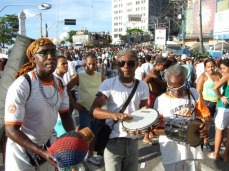Types of Samba
There are a wide range of popular samba styles including samba caranavalesca (carnival), samba-enredo (theme), samba baiana (Bahian), samba-lenco (handkerchief), samba rural, samba de morro (hill), samba da cidade (city), samba de terreiro (yard), samba de breque (break), samba de partido-alto (specialist), samba corrido (verse), samba-cancao (song), samba-choro, and others.
Hill samba and City Samba
The distinction between hill and city samba emerged in the 1930's when members of the ascending middle classes within urban contexts took to the new rhythm. Styles classed as sambas from the hills were those used by the lower classes that lived in shantytowns (favelas) overlooking the respectable neighborhoods. These included the various forms of carnival samba (samba carnavalesco, samba baiana, and samba-enredo), samba de terreiro (sambas played by samba school musicians outside the carnival period), samba de partido alto (sambas in which prominent musicians improvised long verses between refrains), and samba corrido (a style of samba without refrains). City sambas catered to middle-class tastes; they emphasized melody and text, and their composers had better access to recording studios. Their dominant form was song samba (samba-canção), but break samba and choro samba were also popular. In the 1980's, a new form of samba, samba de gafieira, became popular in large urban centers. Gafieiras are large dance halls patronized by the urban working class. In the early 1990's, the samba was fused with reggae to produce samba-reggae.
Urban Sambas
The urban samba, which came to epitomize Brazilian popular music in general, has been strongly identified with Afro-Brazilian expressive urban culture. The first commercially recorded samba, "Pelo Telefone" was the work of the black composer Donga (Ernesto dos Santos). Sinho, called the King of Samba in the 1920s, and Caninha, both black musicians, contributed to the urban genre. It was Pxinguinha, another black composer who had the greatest influence and popularized the urban samba among different social classes in the 20s and 30s. In emphasizing a percussive ensemble and traditional responsorial singing, the samba of the slums in the hills (samba de morro) maintained a closer identity with the folk samba. Out of this ensemble developed the batucada (percussion ensemble and percussive dance music) associated with the samba schools.

